标签:sum back title length manager interrupt sed amr ring
1、实验目的与要求
(1) 掌握线程概念;
(2) 掌握线程创建的两种技术;
(3) 理解和掌握线程的优先级属性及调度方法;
(4) 掌握线程同步的概念及实现技术;
2、实验内容和步骤
实验1:测试程序并进行代码注释。
测试程序1:
l 在elipse IDE中调试运行ThreadTest,结合程序运行结果理解程序;
l 掌握线程概念;
l 掌握用Thread的扩展类实现线程的方法;
利用Runnable接口改造程序,掌握用Runnable接口创建线程的方法。

class Lefthand extends Thread { public void run() { for(int i=0;i<=5;i++) { System.out.println("You are Students!"); try{ sleep(500); } catch(InterruptedException e) { System.out.println("Lefthand error.");} } } } class Righthand extends Thread { public void run() { for(int i=0;i<=5;i++) { System.out.println("I am a Teacher!"); try{ sleep(300); } catch(InterruptedException e) { System.out.println("Righthand error.");} } } } public class ThreadTest { static Lefthand left; static Righthand right; public static void main(String[] args) { left=new Lefthand(); right=new Righthand(); left.start(); right.start(); } }
利用Runnable接口改造程序,掌握用Runnable接口创建线程的方法

class Lefthand implements Runnable { public void run() { for(int i=0;i<=5;i++) { System.out.println("You are Students!"); try{ Thread.sleep(500);//休眠500毫秒 } catch(InterruptedException e) { System.out.println("Lefthand error.");} } } } class Righthand implements Runnable { public void run() { for(int i=0;i<=5;i++) { System.out.println("I am a Teacher!"); try{ Thread.sleep(300);//休眠300毫秒 } catch(InterruptedException e) { System.out.println("Righthand error.");} } } } public class ThreadTest { public static void main(String[] args) { Righthand righthand = new Righthand();//新建一个righthand对象 Lefthand lefthand = new Lefthand();//新建一个lefthand对象 Thread right = new Thread(righthand);//start方法在Thread类中,新建Thread类 right.start(); Thread left=new Thread(lefthand); left.start(); } }
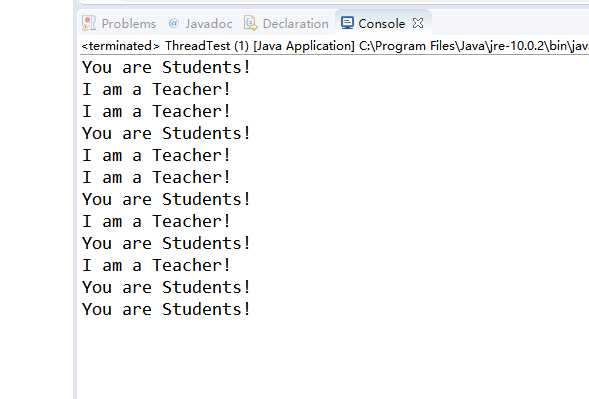
测试程序2:
l 在Elipse环境下调试教材625页程序14-1、14-2 、14-3,结合程序运行结果理解程序;
l 在Elipse环境下调试教材631页程序14-4,结合程序运行结果理解程序;
l 对比两个程序,理解线程的概念和用途;
l 掌握线程创建的两种技术。

package bounce; import java.awt.geom.*; /** * A ball that moves and bounces off the edges of a rectangle * @version 1.33 2007-05-17 * @author Cay Horstmann */ public class Ball { private static final int XSIZE = 15; private static final int YSIZE = 15; private double x = 0; private double y = 0; private double dx = 1; private double dy = 1; /** * Moves the ball to the next position, reversing direction if it hits one of the edges */ public void move(Rectangle2D bounds) { x += dx; y += dy; if (x < bounds.getMinX()) { x = bounds.getMinX(); dx = -dx; } if (x + XSIZE >= bounds.getMaxX()) { x = bounds.getMaxX() - XSIZE; dx = -dx; } if (y < bounds.getMinY()) { y = bounds.getMinY(); dy = -dy; } if (y + YSIZE >= bounds.getMaxY()) { y = bounds.getMaxY() - YSIZE; dy = -dy; } } /** * Gets the shape of the ball at its current position. */ public Ellipse2D getShape() { return new Ellipse2D.Double(x, y, XSIZE, YSIZE); } }

package bounce; import java.awt.*; import java.util.*; import javax.swing.*; /** * The component that draws the balls. * @version 1.34 2012-01-26 * @author Cay Horstmann */ public class BallComponent extends JPanel { private static final int DEFAULT_WIDTH = 450; private static final int DEFAULT_HEIGHT = 350; private java.util.List<Ball> balls = new ArrayList<>(); /** * Add a ball to the component. * @param b the ball to add */ public void add(Ball b) { balls.add(b); } public void paintComponent(Graphics g) { super.paintComponent(g); // erase background Graphics2D g2 = (Graphics2D) g; for (Ball b : balls) { g2.fill(b.getShape()); } } public Dimension getPreferredSize() { return new Dimension(DEFAULT_WIDTH, DEFAULT_HEIGHT); } }

package bounce; import java.awt.*; import java.awt.event.*; import javax.swing.*; /** * Shows an animated bouncing ball. * @version 1.34 2015-06-21 * @author Cay Horstmann */ public class Bounce { public static void main(String[] args) { EventQueue.invokeLater(() -> { JFrame frame = new BounceFrame(); frame.setDefaultCloseOperation(JFrame.EXIT_ON_CLOSE); frame.setVisible(true); }); } } /** * The frame with ball component and buttons. */ class BounceFrame extends JFrame { private BallComponent comp; public static final int STEPS = 1000; public static final int DELAY = 3; /** * Constructs the frame with the component for showing the bouncing ball and * Start and Close buttons */ public BounceFrame() { setTitle("Bounce"); comp = new BallComponent(); add(comp, BorderLayout.CENTER); JPanel buttonPanel = new JPanel(); addButton(buttonPanel, "Start", event -> addBall()); addButton(buttonPanel, "Close", event -> System.exit(0)); add(buttonPanel, BorderLayout.SOUTH); pack(); } /** * Adds a button to a container. * @param c the container * @param title the button title * @param listener the action listener for the button */ public void addButton(Container c, String title, ActionListener listener) { JButton button = new JButton(title); c.add(button); button.addActionListener(listener); } /** * Adds a bouncing ball to the panel and makes it bounce 1,000 times. */ public void addBall() { try { Ball ball = new Ball(); comp.add(ball); for (int i = 1; i <= STEPS; i++) { ball.move(comp.getBounds()); comp.paint(comp.getGraphics()); Thread.sleep(DELAY); } } catch (InterruptedException e) { } } }
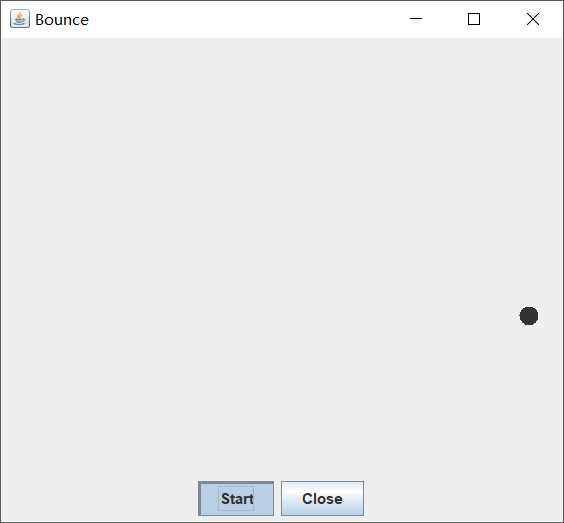

package bounceThread; import java.awt.*; import java.awt.event.*; import javax.swing.*; /** * Shows animated bouncing balls. * @version 1.34 2015-06-21 * @author Cay Horstmann */ public class BounceThread { public static void main(String[] args) { EventQueue.invokeLater(() -> { JFrame frame = new BounceFrame(); frame.setTitle("BounceThread"); frame.setDefaultCloseOperation(JFrame.EXIT_ON_CLOSE); frame.setVisible(true); }); } } /** * The frame with panel and buttons. */ class BounceFrame extends JFrame { private BallComponent comp; public static final int STEPS = 1000; public static final int DELAY = 5; /** * Constructs the frame with the component for showing the bouncing ball and * Start and Close buttons */ public BounceFrame() { comp = new BallComponent(); add(comp, BorderLayout.CENTER); JPanel buttonPanel = new JPanel(); addButton(buttonPanel, "Start", event -> addBall()); addButton(buttonPanel, "Close", event -> System.exit(0)); add(buttonPanel, BorderLayout.SOUTH); pack(); } /** * Adds a button to a container. * @param c the container * @param title the button title * @param listener the action listener for the button */ public void addButton(Container c, String title, ActionListener listener) { JButton button = new JButton(title); c.add(button); button.addActionListener(listener); } /** * Adds a bouncing ball to the canvas and starts a thread to make it bounce */ public void addBall() { Ball ball = new Ball(); comp.add(ball); Runnable r = () -> { try { for (int i = 1; i <= STEPS; i++) { ball.move(comp.getBounds()); comp.repaint(); Thread.sleep(DELAY); } } catch (InterruptedException e) { } }; Thread t = new Thread(r); t.start(); } }
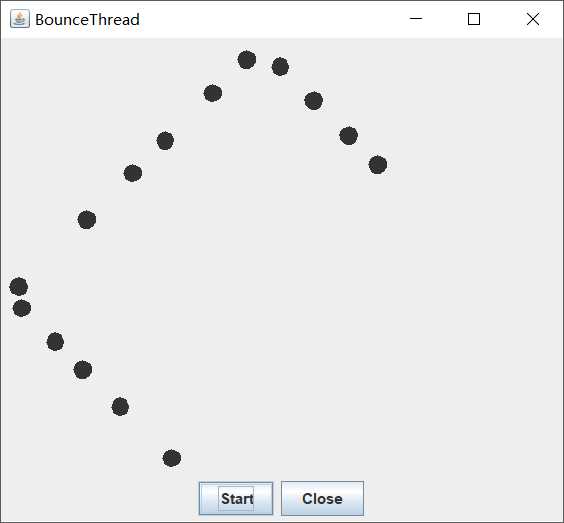
测试程序3:分析以下程序运行结果并理解程序。

class Race extends Thread { public static void main(String args[]) { Race[] runner=new Race[4]; for(int i=0;i<4;i++) runner[i]=new Race( ); for(int i=0;i<4;i++) runner[i].start( ); runner[1].setPriority(MIN_PRIORITY); runner[3].setPriority(MAX_PRIORITY);} public void run( ) { for(int i=0; i<1000000; i++); System.out.println(getName()+"线程的优先级是"+getPriority()+"已计算完毕!"); } }
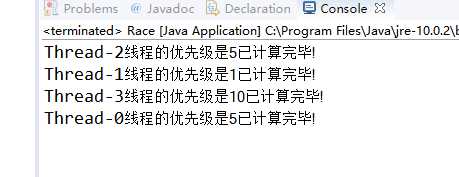
测试程序4
l 教材642页程序模拟一个有若干账户的银行,随机地生成在这些账户之间转移钱款的交易。每一个账户有一个线程。在每一笔交易中,会从线程所服务的账户中随机转移一定数目的钱款到另一个随机账户。
l 在Elipse环境下调试教材642页程序14-5、14-6,结合程序运行结果理解程序;

package unsynch; /** * This program shows data corruption when multiple threads access a data structure. * @version 1.31 2015-06-21 * @author Cay Horstmann */ public class UnsynchBankTest { public static final int NACCOUNTS = 100; public static final double INITIAL_BALANCE = 1000;//期初余额 public static final double MAX_AMOUNT = 1000;//最大数量 public static final int DELAY = 10;//延时 public static void main(String[] args) { Bank bank = new Bank(NACCOUNTS, INITIAL_BALANCE); for (int i = 0; i < NACCOUNTS; i++) { int fromAccount = i; Runnable r = () -> { try { while (true) { int toAccount = (int) (bank.size() * Math.random());//生成随机数 double amount = MAX_AMOUNT * Math.random(); bank.transfer(fromAccount, toAccount, amount); Thread.sleep((int) (DELAY * Math.random())); } } catch (InterruptedException e) { } }; Thread t = new Thread(r); t.start(); } } }

package unsynch; import java.util.*; /** * A bank with a number of bank accounts. * @version 1.30 2004-08-01 * @author Cay Horstmann */ public class Bank { private final double[] accounts; /** * Constructs the bank. * @param n the number of accounts * @param initialBalance the initial balance for each account */ public Bank(int n, double initialBalance) { accounts = new double[n]; Arrays.fill(accounts, initialBalance); } /** * Transfers money from one account to another. * @param from the account to transfer from * @param to the account to transfer to * @param amount the amount to transfer */ public void transfer(int from, int to, double amount) { if (accounts[from] < amount) return; System.out.print(Thread.currentThread()); accounts[from] -= amount; System.out.printf(" %10.2f from %d to %d", amount, from, to); accounts[to] += amount; System.out.printf(" Total Balance: %10.2f%n", getTotalBalance()); } /** * Gets the sum of all account balances. * @return the total balance */ public double getTotalBalance() { double sum = 0; for (double a : accounts) sum += a; return sum; } /** * Gets the number of accounts in the bank. * @return the number of accounts */ public int size() { return accounts.length; } }
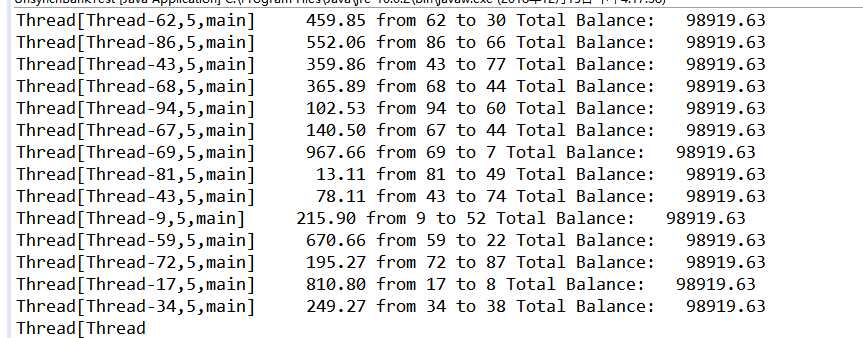
综合编程练习
编程练习1
用户信息输入界面如下图所示:

(1) 用户点击提交按钮时,用户输入信息显示控制台界面;
(2) 用户点击重置按钮后,清空用户已输入信息;
(3) 点击窗口关闭,程序退出。

import java.awt.EventQueue; import javax.swing.JFrame; public class Mian { public static void main(String[] args) { EventQueue.invokeLater(() -> { DemoJFrame page = new DemoJFrame(); }); } }

import java.awt.Color; import java.awt.Dimension; import java.awt.FlowLayout; import java.awt.GridLayout; import java.awt.LayoutManager; import java.awt.Panel; import java.awt.event.ActionEvent; import java.awt.event.ActionListener; import java.io.BufferedReader; import java.io.File; import java.io.FileInputStream; import java.io.IOException; import java.io.InputStreamReader; import java.util.ArrayList; import java.util.Timer; import java.util.TimerTask; import javax.swing.BorderFactory; import javax.swing.ButtonGroup; import javax.swing.ButtonModel; import javax.swing.JButton; import javax.swing.JCheckBox; import javax.swing.JComboBox; import javax.swing.JFrame; import javax.swing.JLabel; import javax.swing.JPanel; import javax.swing.JRadioButton; import javax.swing.JTextField; public class DemoJFrame extends JFrame { private JPanel jPanel1; private JPanel jPanel2; private JPanel jPanel3; private JPanel jPanel4; private JTextField fieldname; private JComboBox comboBox; private JTextField fieldadress; private ButtonGroup bg; private JRadioButton nan; private JRadioButton nv; private JCheckBox sing; private JCheckBox dance; private JCheckBox draw; public DemoJFrame() { // 设置窗口大小 this.setSize(800, 400); // 设置可见性 this.setVisible(true); // 设置标题 this.setTitle("Student Detail"); // 设置关闭操作 this.setDefaultCloseOperation(EXIT_ON_CLOSE); // 设置窗口居中 WinCenter.center(this); // 创建四个面板对象 jPanel1 = new JPanel(); setJPanel1(jPanel1); jPanel2 = new JPanel(); setJPanel2(jPanel2); jPanel3 = new JPanel(); setJPanel3(jPanel3); jPanel4 = new JPanel(); setJPanel4(jPanel4); // 设置容器为流式布局 FlowLayout flowLayout = new FlowLayout(); this.setLayout(flowLayout); // 将四个面板添加到容器中 this.add(jPanel1); this.add(jPanel2); this.add(jPanel3); this.add(jPanel4); } /* * 设置面板一 */ private void setJPanel1(JPanel jPanel) { jPanel.setPreferredSize(new Dimension(700, 45));//设置此组件的首选大小 // 给面板的布局设置为网格布局 一行4列 jPanel.setLayout(new GridLayout(1, 4)); JLabel name = new JLabel("Name:"); name.setSize(100, 50); fieldname = new JTextField(""); fieldname.setSize(80, 20); JLabel study = new JLabel("Qualification:"); comboBox = new JComboBox(); comboBox.addItem("Graduate"); comboBox.addItem("senior"); comboBox.addItem("Undergraduate"); jPanel.add(name); jPanel.add(fieldname); jPanel.add(study); jPanel.add(comboBox); } /* * 设置面板二 */ private void setJPanel2(JPanel jPanel) { jPanel.setPreferredSize(new Dimension(700, 50)); // 给面板的布局设置为网格布局 一行4列 jPanel.setLayout(new GridLayout(1, 4)); JLabel name = new JLabel("Address:"); fieldadress = new JTextField(); fieldadress.setPreferredSize(new Dimension(150, 50)); JLabel study = new JLabel("Hobby:"); JPanel selectBox = new JPanel(); selectBox.setBorder(BorderFactory.createTitledBorder("")); selectBox.setLayout(new GridLayout(3, 1)); sing = new JCheckBox("Singing"); dance = new JCheckBox("Dancing"); draw = new JCheckBox("Reading"); selectBox.add(sing); selectBox.add(dance); selectBox.add(draw); jPanel.add(name); jPanel.add(fieldadress); jPanel.add(study); jPanel.add(selectBox); } /* * 设置面板三 */ private void setJPanel3(JPanel jPanel) { jPanel.setPreferredSize(new Dimension(700, 150)); FlowLayout flowLayout = new FlowLayout(FlowLayout.LEFT); jPanel.setLayout(flowLayout); JLabel sex = new JLabel("Sex:"); JPanel selectBox = new JPanel(); selectBox.setBorder(BorderFactory.createTitledBorder("")); selectBox.setLayout(new GridLayout(2, 1)); bg = new ButtonGroup(); nan = new JRadioButton("Male"); nv = new JRadioButton("Female"); bg.add(nan); bg.add(nv); selectBox.add(nan); selectBox.add(nv); jPanel.add(sex); jPanel.add(selectBox); } /* * 设置面板四 */ private void setJPanel4(JPanel jPanel) { // TODO 自动生成的方法存根 jPanel.setPreferredSize(new Dimension(700, 150)); FlowLayout flowLayout = new FlowLayout(FlowLayout.CENTER, 50, 10); jPanel.setLayout(flowLayout); jPanel.setLayout(flowLayout); JButton sublite = new JButton("Validate"); JButton reset = new JButton("Reset"); sublite.addActionListener((e) -> valiData()); reset.addActionListener((e) -> Reset()); jPanel.add(sublite); jPanel.add(reset); } /* * 提交数据 */ private void valiData() { // 拿到数据 String name = fieldname.getText().toString().trim(); String xueli = comboBox.getSelectedItem().toString().trim(); String address = fieldadress.getText().toString().trim(); System.out.println(name); System.out.println(xueli); String hobbystring=""; if (sing.isSelected()) { hobbystring+="Singing "; } if (dance.isSelected()) { hobbystring+="Dancing "; } if (draw.isSelected()) { hobbystring+="Reading "; } System.out.println(address); if (nan.isSelected()) { System.out.println("Male"); } if (nv.isSelected()) { System.out.println("Female"); } System.out.println(hobbystring); } /* * 重置 */ private void Reset() { fieldadress.setText(null); fieldname.setText(null); comboBox.setSelectedIndex(0); sing.setSelected(false); dance.setSelected(false); draw.setSelected(false); bg.clearSelection(); } }

import java.awt.Dimension; import java.awt.Toolkit; import java.awt.Window; public class WinCenter { public static void center(Window win){ Toolkit tkit = Toolkit.getDefaultToolkit();//获取默认工具包 Dimension sSize = tkit.getScreenSize();//获取屏幕的大小 Dimension wSize = win.getSize(); if(wSize.height > sSize.height){ wSize.height = sSize.height; } if(wSize.width > sSize.width){ wSize.width = sSize.width; } win.setLocation((sSize.width - wSize.width)/ 2, (sSize.height - wSize.height)/ 2);//将组件移到新的位置 } }
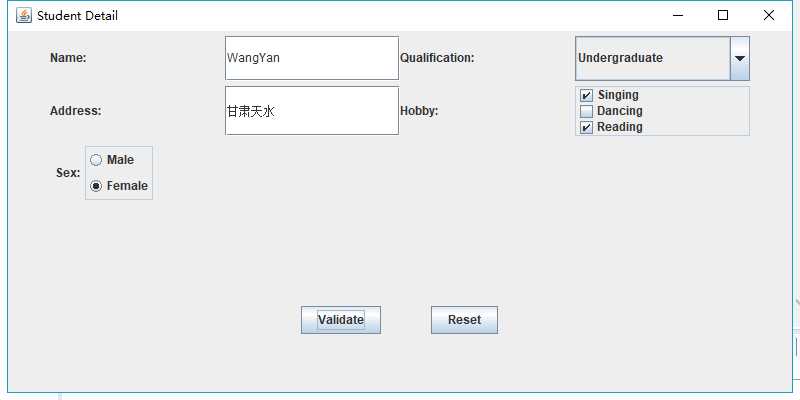
2.创建两个线程,每个线程按顺序输出5次“你好”,每个“你好”要标明来自哪个线程及其顺序号。

package shiyan2; public class xiancheng { static xian1 xian11; static xian2 xian22; public static void main(String[] args) { xian11=new xian1(); xian22=new xian2(); //用start()方法启动线程 xian11.start(); xian22.start(); } } class xian1 extends Thread { public void run() { for(int i=1;i<=5;i++) { System.out.println( i+ "你好"+" 来自线程1"); try{ sleep(200); } catch(InterruptedException e) //异常 { System.out.println("Lefthand error.");} } } } class xian2 extends Thread { public void run() { for(int i=1;i<=5;i++) { System.out.println( i+ "你好"+" 来自线程2"); try{ sleep(200); } catch(InterruptedException e)//异常捕获 { System.out.println("Lefthand error.");} } } }
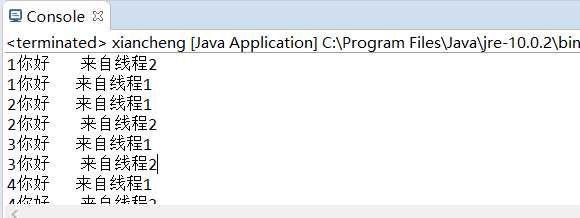
3. 完善实验十五 GUI综合编程练习程序。
实验总结
通过本周的学习我了解了线程的概念,并且了解了线程创建的两种技术、线程的优先级属性及调度方法以及终止线程的方法,(1)用Thread类的子类创建线程(2)用Runnable()接口实现线程;理解了线程的优先级属性及调度方法和线程的七种状态。但是这些知识掌握还不牢靠,需要课下多加练习。
201771010109焦旭超《面向对象程序设计(java)》第十六周学习总结
标签:sum back title length manager interrupt sed amr ring
原文地址:https://www.cnblogs.com/lcjcc/p/10126884.html